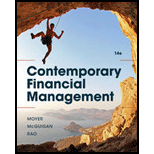
a.
To determine: The amount of funds released.
a.
Answer to Problem 3P
The amount of funds released is $2,465,753.42.
Explanation of Solution
Determine the reduction in collection time
Therefore, the reduction in collection time is 5 days.
Determine the average daily collection
Therefore, the average daily collection is $493,150.68.
Determine the amount of funds released
Therefore, the amount of funds released is $2,465,753.42.
b.
To determine: The annual earnings on the released funds.
b.
Answer to Problem 3P
The annual earnings on the released funds is $2,465,753.42.
Explanation of Solution
Determine the annual earnings on the released funds
Therefore, the annual earnings on the released funds is $246,575.34.
c.
To determine: The annual fee.
c.
Answer to Problem 3P
The annual fee is $315,000.
Explanation of Solution
Determine the annual fee
Therefore, the annual fee is $315,000.
d.
To determine: The annual net benefits.
d.
Answer to Problem 3P
The annual net benefits are -$18,424.66.
Explanation of Solution
Determine the annual net benefits
Therefore, the annual net benefits are -$18,424.66.
e.
To determine: The annual net benefits.
e.
Answer to Problem 3P
The annual net benefits are $121,917.95.
Explanation of Solution
Determine the amount of funds released
Therefore, the amount of funds released is $2,465,753.42.
Determine the annual net benefits
Therefore, the annual net benefits are $121,917.95.
f.
To discuss: The lockbox system the firm should select.
f.
Answer to Problem 3P
The lockbox system the firm should select is SLC bank’s lockbox system.
Explanation of Solution
Since SLC’s bank provides a higher net benefits for the firm, the lockbox system that the firm should select is SLC bank’s lockbox system.
Want to see more full solutions like this?
Chapter 17 Solutions
Contemporary Financial Management, Loose-leaf Version
- A comparative balance sheet and income statement is shown for Cruz, Incorporated. CRUZ, INCORPORATED Comparative Balance Sheets At December 31 2021 2020 Assets Cash Accounts receivable, net $ 85,600 36,800 $ 21,300 Prepaid expenses Inventory Total current assets Furniture Accumulated depreciation-Furniture Total assets Liabilities and Equity Accounts payable Wages payable 77,100 45,200 84,900 4,700 3,900 204,200 155,300 94,700 (14,700) $ 284,200 $ 13,400 8,000 (8,400) $ 257,400 $ 19,000 4,500 110,500 Income taxes payable 1,400 2,500 Total current liabilities Notes payable (long-term) Total liabilities Equity Common stock, $5 par value Retained earnings 22,800 26,000 28,900 66,400 51,700 92,400 204,000 28,500 162,300 2,700 Total liabilities and equity $ 284,200 $ 257,400 CRUZ, INCORPORATED Income Statement Sales For Year Ended December 31, 2021 $ 440,700 283,700 157,000 Cost of goods sold Gross profit Operating expenses (excluding depreciation) Depreciation expense Income before taxes…arrow_forwardHow do you calculate the intrinsic value of a stock using the dividend discount model (DDM)? Need help.arrow_forwardExplain the Modigliani-Miller theorem and its assumptions In finance?arrow_forward
- How do you calculate the intrinsic value of a stock using the dividend discount model (DDM)? i need coarrow_forwardHow do you calculate the intrinsic value of a stock using the dividend discount model (DDM)?arrow_forwardHow does the weighted average cost of capital (WACC) affect a company’s valuation? i need help in this qarrow_forward
- How does the weighted average cost of capital (WACC) affect a company’s valuation?i need correct answer.arrow_forwardHow does the weighted average cost of capital (WACC) affect a company’s valuation?i need help.arrow_forwardHow does the weighted average cost of capital (WACC) affect a company’s valuation? Need helparrow_forward
 EBK CONTEMPORARY FINANCIAL MANAGEMENTFinanceISBN:9781337514835Author:MOYERPublisher:CENGAGE LEARNING - CONSIGNMENT
EBK CONTEMPORARY FINANCIAL MANAGEMENTFinanceISBN:9781337514835Author:MOYERPublisher:CENGAGE LEARNING - CONSIGNMENT

